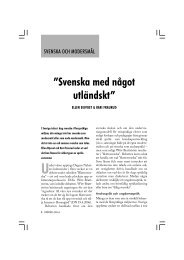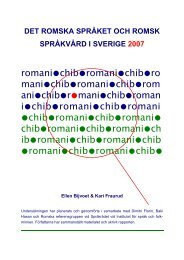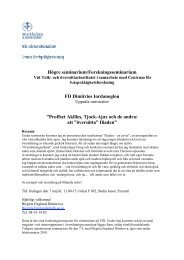Abstracts – NORDAND 11 - Centrum för tvåspråkighetsforskning ...
Abstracts – NORDAND 11 - Centrum för tvåspråkighetsforskning ...
Abstracts – NORDAND 11 - Centrum för tvåspråkighetsforskning ...
Create successful ePaper yourself
Turn your PDF publications into a flip-book with our unique Google optimized e-Paper software.
<strong>Abstracts</strong> <strong>–</strong> <strong>NORDAND</strong> <strong>11</strong><br />
Virtanen, Aija Lördag, sektion 6D, sal F420<br />
University of Jyväskylä<br />
Intersections of affordances: second language learning in hospital<br />
settings<br />
Work-related language skills have been under a public debate as the amount of international<br />
workforce in the health care sector has been increasing in Finland. So far, however, there has<br />
been little discussion about international nursing students and their language skills.<br />
The aim of this study is to provide an insight into language learning opportunities that international<br />
nursing students perceive during their practical training. This kind of relation between<br />
the individual and the environment is defined as an affordance. The theoretical framework is<br />
based on a sociocognitive approach, combining dialogical and sociocultural perspectives, where<br />
language is seen as a shared, dynamic and varying phenomenon. (Linell 2009, van Lier 2004.)<br />
A case study is reported: the data include a student’s narrative, her workplace interaction and<br />
reflections about observed situation and a semi-structured interview with the student’s mentor.<br />
To find out what the intersections of perceived affordances are, nexus analysis is applied<br />
(Scollon & Scollon 2004) to highlight the dynamic nature and the historical context of the<br />
action in situ.<br />
The study is a part of the project Finnish as a work language: A sociocognitive perspective to<br />
work-related language skills of immigrants (University of Jyväskylä 20<strong>11</strong><strong>–</strong>2013).<br />
References<br />
Linell, P. (2009). Rethinking Language, Mind, and World Dialogically. Charlotte, N.C.: IAP Press.<br />
Scollon, R. & Scollon, S.W. (2004). Nexus Analysis: Discourse and the Emerging Internet. London:<br />
Routledge.<br />
van Lier, L. (2004). The Ecology and Semiotics of Language Learning. A Sociocultural Perspective.<br />
Boston: Kluwer Academic.<br />
Vukovska, Boriana* & Maya Vukovska** Fredag, sektion 5A, hörsal F<strong>11</strong><br />
*University of Agder & **South West University of Blagoevgrad<br />
“Girlsa skal rocke i kveld, u know”: On the use of Norwegian as a second<br />
language in a super‐diverse community<br />
In this paper, we aim at analyzing the use of Norwegian as a second language by native speakers<br />
of Bulgarian in the social networks. Our analysis shows that the Norwegian they use in their<br />
communication is not the “pure” bokmål they learned from the textbooks and theirteachers, but<br />
a clear case of polylanguaging.<br />
The relatively new term polylanguaging (coined by representatives of the Danish sociolinguistic<br />
community; see Jørgensen, Karrebæk, Madsen & Møller 20<strong>11</strong>) is intended to substitute<br />
other terms such as “bilingualism” and “multilingualism”, and covers phenomena<br />
previously termed as “codeswitching”and “code-mixing”. A polylanguage utterance may consist<br />
of linguistic featuresfrom two, three and even more lexicons, but the grammar and syntax that<br />
bind them alltogether comes from only one of the languages (that is Norwegian in our case), and<br />
can beillustrated by the following examples: “Gleder meg til å treffe my people i kveld.” “Hvor<br />
fucked up er man når man legger mobilen sin i kjøleskapet!”<br />
For our purpose we present examples of the observed language use from among youth in a<br />
super-diverse community (such is the social network Facebook). We describe and analyze the<br />
linguistic behavior of two Bulgarian female students, for whom Norwegian is a second<br />
language, and who live, study and work in Kristiansand, Norway. The conversations are a mix<br />
of bokmål, the local dialect, standard English, English slang, and Bulgarian (written in Latin<br />
letters, not Cyrillic).<br />
51





